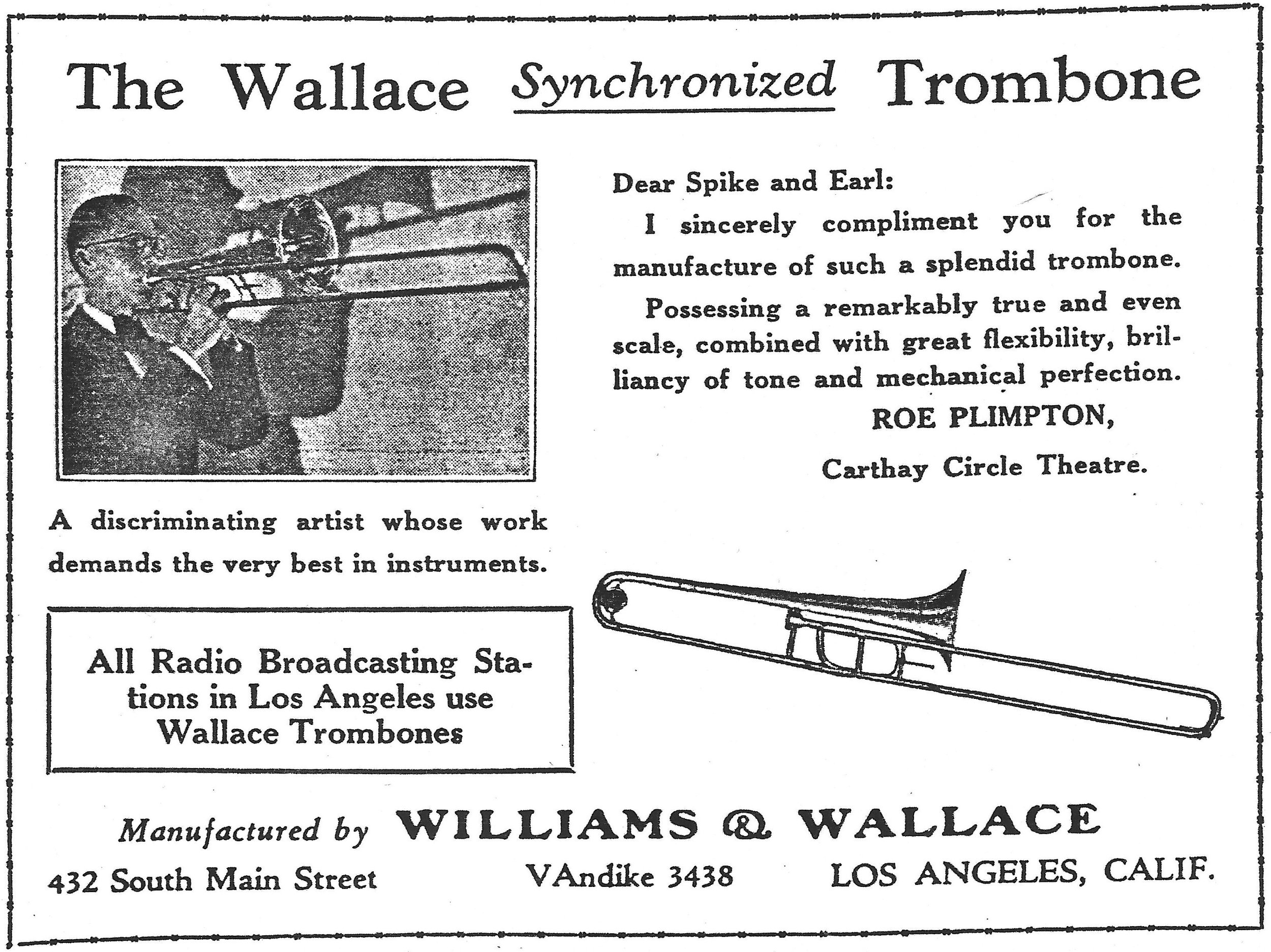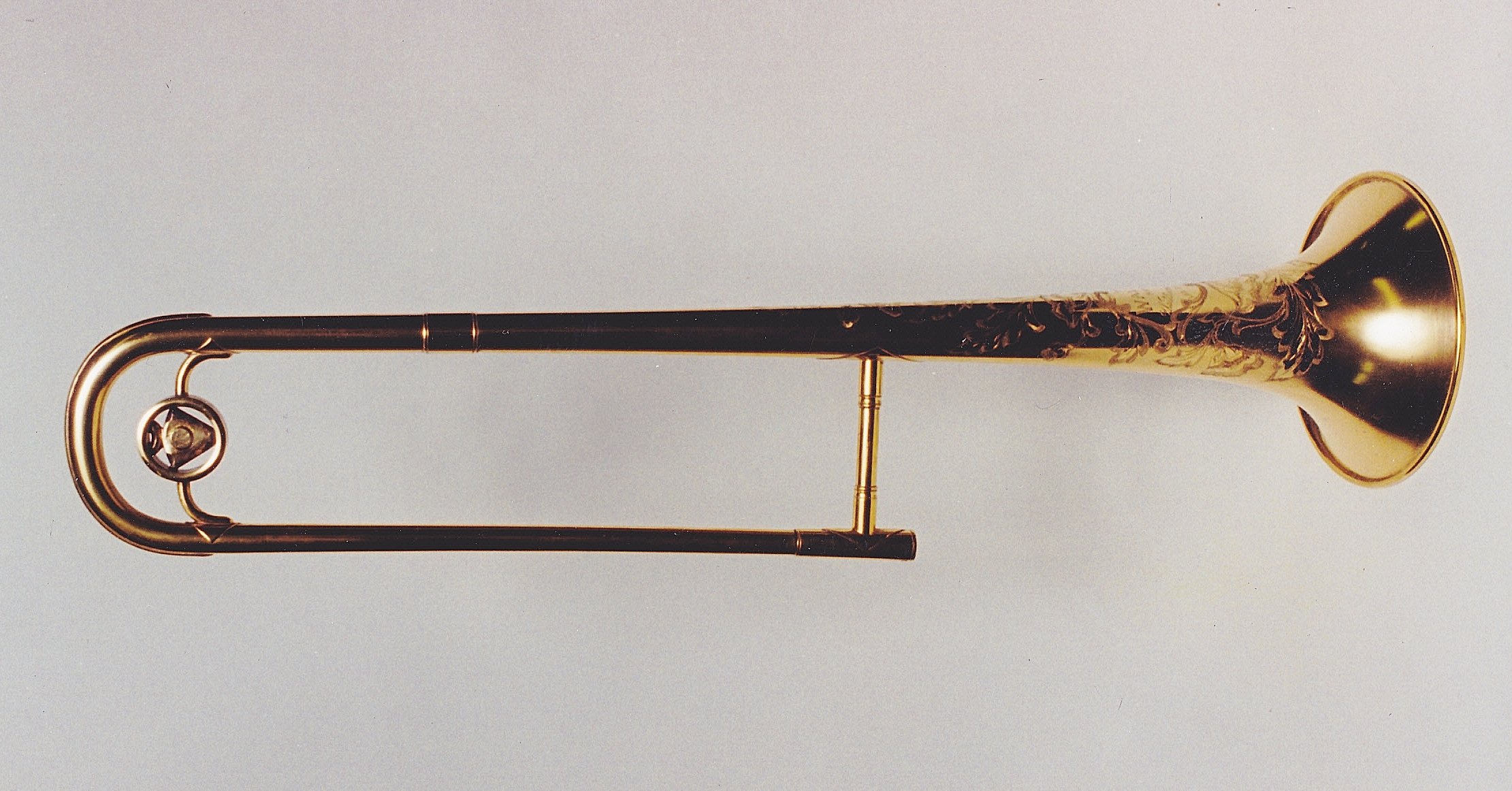Earl Williams History
I first started to collect historical information on Earl Williams, the great trombone maker in about 1990, and without internet searches, email etc. the file was quite thin. I continued over the years to add to the file and eventually had access to census and other records at my computer. I later (Feb. 2013) was able to interview his youngest daughter, Doris and two of his granddaughters and added and corrected a few bits of this story. The following is the history as best as I can piece it together. I encourage you to contact me if you find any errors or have additional information. Unfortunately, I still don't have any pages on this website featuring Williams trombones, but I do have both Williams and Wallace and Williams trumpets featured.
Earl Orbra Williams was born on the 24th of March, 1890 in the small Ohio village of Gibsonburg which is less than 30 miles from Toledo. Toledo is where the family lived at the time of the 1900 US census. In 1910, Earl was still living with the family, which had moved to Elkhart, Indiana. 20 year old Earl was listed in the census that year as “machinist helper”. According to his daughter Doris, he worked for a musical instrument maker there and she thinks that it was C.G. Conn.
About five years later, he was working for F.E. Olds in Los Angeles, who had worked for Conn in the early 1880s. He was still working for Olds in 1917, when he registered for the draft (subsequently drafted and served during the war), and was married and had a 4 year old daughter at that time. By the 1920 census, he was single again, renting a room in a boarding house and listed as self employed band instrument repairman.
Click on image for larger views.
In 1920, he married Marcella Wolfer, daughter of William Wolfer of Wolfer Printing and Publishing. Williams never had a close relationship with his father in law. By the 1930 census, he was living at 438 E. Thirtieth Street with three children and an estate of $5500 and listed as self employed musical instrument manufacturer. The photos below show him at about this time in his life.
The photo showing him next to a giant tuba was most likely taken in front of W.W. Jones' music store 929 W. 7th Street in Los Angeles. Mr Jones owned this instrument by 1910 and probably into the 1920s. This is the same FF or EEb tuba that was associated with Paxman in London for many years and famously played on an album by Gerard Hoffnung.
In 1920, Williams lived just 12 blocks from the original Olds shop at 206 W. 24th St., although I have not been able to learn if he went back to work for Olds after coming back from the war. In about 1922, Olds moved into a much larger building at 1914 Raymond Ave. several miles away.
By 1924 Williams was renting a room for his shop in the Canadian Building at 432 South Main Street in downtown Los Angeles (this building still stands), repairing brass instruments and presumably continuing what he had learned at Olds about building trombones. The Maple Ave. streetcar took him directly to work with only three blocks to walk. No instruments of his own manufacture are known from this time.
In 1925 he applied for his first patent which was a slight variation of the Olds tuning mechanism and almost identical to that being used by Conn at that time. This patent was granted early in 1928 at which time he applied for his second patent covering his curved hand slide brace (granted Nov. 25, 1930). If you see one of these trombones with the brace stamped: "Patent Pending", it was made before that date).
In a different room in the same building Williams formed a partnership with J.K. “Spike” Wallace of the Los Angeles Philharmonic Orchestra in 1928, to produce the Williams and Wallace trombones. These instruments were similar to the Olds trombones in some respects, such as tuning in the hand slide, but with a few innovations of their own, most notably the patented brace. In some instruments the tuning mechanism simplified by cutting a slot in one of the outer tuning tubes that slid on a key or tab soldered to the slide tube. This reduced the weight of the assembly.
The image above is an advertisement published in “Overture”, the newsletter of the Los Angeles Musicians Union, Local 47, shortly after the formation of the partnership. This features Roe Plimpton, who is mostly remembered for his custom mouthpieces that he made at F.E. Olds and Son. The image below was published in “Down Beat” March 15, 1945 and shows Spike Wallace in a publicity photos with Paul Whiteman. Almost a decade after the end of the partnership, he is still playing his Williams and Wallace trombone.
Williams’ other interests included nature, Western history, shooting/hunting and archery and this was often expressed in the engraved designs on the trombone bells, which included American Indian portraits. Dogs were also a common theme, but Doris doesn't remember her father having any particular interest in them.
Williams had an employee about this time, Cliff from England, who engraved some of the trombones. Eventually, Cliff was deported back to England. Times were hard in the 1930s and the partnership dissolved in 1936 after making approximately 500 trombones and at least one trumpet. It seems likely that after this date is when he first produced trombones signed with his own name only.
At about this time, Williams broke his leg while taking down a swing set and took to drinking while recovering. In 1937, Marcella's mother died and the Williams family moved in with William Wolfer. Eventually he had to give up his shop and rented a small space from Harry Garlock, a prominent repairer of woodwinds, who had also worked at Olds and had a shop on Venice Boulevard.
He continued repairing brass instruments there as he had in the 1920’s. He would build a few trombones as orders came in and he also built a small number of trumpets. Williams also built slides for Selmer US (Elkhart, Indiana) for their "Triple Threat" model trombone using his patented curved handslide brace. One of these is shown in the photos below.
During these years, Williams was refining his designs resulting in his models 4, 6 and 8, with bores measuring .490”, .500” and .522” respectively and each model with its own bell design appropriate for the bore. The model 6 became his most popular product and is what he is best remembered for today.
Like every other US maker Earl Williams contracted to do war production in 1942. He went to work full time for Boeing in Burbank, but Doris remembers that he also produced an item on his own that nobody else wanted to make. By the time that the war was over he was in much better shape financially and the post war years continued to be profitable, making his new model trombones.
In 1945, Williams applied for a patent, granted in 1948, for a curved waterkey that appeared on all his trombones after that date. He added to his production bass trombones, model 10, and versions of the models 6 and 8 with F valves that he designated models 7 and 9 respectively. In 1958, the Williams family moved to a fairly large property on the corner of Burbank Blvd. and Mariposa St. A shop was then built facing Mariposa (920 N. Mariposa St.), where Williams did all of his business from then on.
Williams continued his interest in archery and shooting and in this shop, a part of the business was manufacturing arrows from thin aluminum tubing that he drew to his own specifications. His secret formula for lubrication for drawing and spinning was so successful that he was able to sell this to a local supplier of polishing machines and supplies. He was granted one last patent in 1964, for a drill designed for gun barrels.
After Earl William’s death, July 5, 1971, his son Bob continued to make the same basic trombone models in small numbers in the Williams shop. After Bob William’s death November 1, 1977, the shop was closed.
It was widely known that the Williams trombone tooling and machinery was for sale but very expensive. In the early 1980s, Larry Minick had plans to expand his trombone making activities, so he took a look at what was there. He determined that the asking price was too high for the antiquated machinery and mandrels that had become rusty.
Zig Kanstul and Chuck Levin also looked over the tooling and saw enough promise in the dormant company that they purchased a 30 day option to buy for $1. Kanstul’s own business was only in the formation stages and they couldn’t get larger makers interested in the venture, so they let it go.
The business was purchased by Mary and Jay Armstrong, who produced trombones in Donelson, Tennessee for some years and eventually sold to Calicchio back in Los Angeles. More trombones were produced there, but there just wasn’t enough time or space to devote to them so Calicchio eventually sold the Williams company to Richard Chovner in Riverside, California, who planned to produce the trombones but didn’t have the resources.
After Calicchio moved to Tulsa Oklahoma, they bought back the company and reestablished their production of trombones The main force behind Calicchio during the later years is John Duda, son of Benge’s foreman, Lou Duda. After attempting to have some of the trombone building contracted out to other shops, there continued to be logistical problems that prevented much success.
The economic recession made matters worse, and John looked for other options. After several years, sharing shop quarters with Marcikiewicz in Canby, Oregon, Duda moved Kansas City, Missouri, in the same shop as Mike Corrigan's BAC Music. BAC will now be producing Williams trombones.
My thanks go to John Noxon for providing some of the post-war facts above. There is additional information about the later years of the company on Facebook, which John can link you to.
















